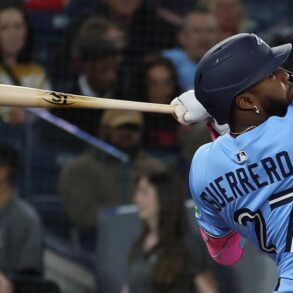The Launch of the Torpedo Bat
The New York Yankees have always liked size: big stars, big contracts, big games, big bodies. A short porch in right field, sure—but all the better for hitting big bombs. So perhaps it’s not surprising that, in 2023, when Aaron Leanhardt, who was, at the time, a minor-league hitting coördinator for the team, asked players what might help them overcome the dominance of modern pitching (the league’s batting average was at its lowest point in more than half a century), he found an answer: bigger barrels on their bats.
Before then, Leanhardt had never really thought about the design of bats, any more than he’d thought about his glove or his spikes, he recently told reporters. But he was well positioned to examine the matter. Leanhardt had spent seven years as a physics professor at the University of Michigan before leaving academia to become a baseball coach. He has a Ph.D. from M.I.T., and was once part of a research team that cooled sodium gas to the lowest temperature ever recorded. And hitting is basic physics: a transfer of energy between two moving objects. Anyone who has ever played a beer-league softball game can tell you that where the ball hits the bat matters enormously for that transfer of energy. Hit the ball too far up the handle, or off the end of the head, and the bat will flex and vibrate, transferring less energy to the ball and stinging the batter’s hands. But, when the ball hits what many people refer to as the center of percussion, it will rebound without rotating—that’s the sweet feeling of hitting the sweet spot. When a ball is not only travelling around a hundred miles an hour but also zigging and zagging with a spin, it’s very hard to hit it in just the right place. And, of course, it’s harder for some than others.
So the Yankees used high-speed cameras to measure players’ points of contact. None of this was top secret: the M.L.B.’s website already posts the relative rate at which players connect the barrel of the bat with the ball. Aaron Judge, the Yankees’ center fielder and a future Hall of Famer, hit the ball with the barrel of the bat nearly thirty per cent of the time he made contact last season—far and away the best in the league. Anthony Volpe, the team’s shortstop, had a barrel percentage of less than four per cent, near the bottom of the barrel, so to speak.
The Yankees’ analytics department got more granular. According to the Yankees’ announcer on the YES Network, Michael Kay, Leanhardt studied precisely where Volpe usually made contact, and found that it was right near the label, below the barrel. What if they could move the location of the sweet spot closer to the usual point of contact? They wanted to put more mass behind the ball. But a bigger barrel would make for a heavier bat, and a slower swing—unless they redistributed the mass that was already there. So the Yankees worked with a manufacturer on a design that tapered the tip, making the head lighter—putting the mass where it would be more useful, and by concentrating the weight closer to the hands, making the bat feel lighter and easier to whip around, while at the same time offering more control. The new design turned the typical shape of a baseball bat into something more closely resembling a bowling pin. Eventually, other teams started working with the bat company as well, and the bat-makers spent about eighteen months tinkering with the swing weight, refining and customizing the new bats for players willing to experiment. By the playoffs last season, a few players, including Volpe, were hitting with the new bats—which are now called “torpedo bats” (presumably because this sounds cooler than “bowling-pin bats”). And, immediately, Volpe, who had been among the league’s worst hitters for weeks before the post-season, looked more like Judge than Judge did.
It’s not that no one noticed that Volpe was the Yankees’ third-best hitter during the post-season, behind Juan Soto, one of the greatest hitters ever, and Giancarlo Stanton, who was also swinging a torpedo. And it’s not that the bats were a secret, either; the distinct bulge of the barrel, after all, was in plain sight, and players on other teams had started to ask around about them, too. But, when the Athletic wrote a story on Volpe’s sudden acceleration in bat speed and exit velocity, in early March, the focus was on the way he shifted his weight in his batting stance. No one mentioned his bat.
Then came the home-run barrage. A friend texted me last Sunday; the Yankees had just hit three homers on the first three pitches of a game against the Milwaukee Brewers, the first time in history that this had happened. I turned on the game just in time to see the replay of the team’s fourth homer of the first inning. By the end of that one game, the Yankees had hit nine home runs, more than most teams have hit so far all season. And still the new bats might have gone unnoticed by many had Kay, the Yankees’ announcer, not pointed out the bulbous bat of Jazz Chisholm shortly before Chisholm hit a single during the rout of the Brewers a week ago. Then Volpe hit yet another home run. Kevin Smith, a former Yankee who is now retired, had tweeted out credit to Leanhardt for working on the bat design. Within twenty-four hours of the game, Leanhardt was baseball’s biggest celebrity since Shohei Ohtani’s dog.
Once again, the Yankees’ big bats were the envy of everyone. Some said the torpedo bats should be banned, and others denounced the Yankees for breaking the rules. They weren’t: the only relevant regulations say that a bat must be made of a single piece of wood, no longer than forty-two inches, and no wider than 2.61 inches. Refining bats to match the individual swings of players, in fact, is not a radically new idea. In a game of such fine margins, it makes sense that marginal improvements can make a major difference. And players have toyed with differently shaped bats before. Some use bats with a curved handle—so-called “axe bats.” There have been handles shaped like hockey pucks, and bats with divots on the far end, to cut some of the mass out. Bats were made of ash until Barry Bonds used maple, and everyone else followed suit. And, given that the game has become so weighted toward pitchers, who are innovating all the time (look out for the kick-change pitch this season), a slight improvement in equipment that might help batters get the barrel on the ball could be a welcome evolution. After all, “we’re just swinging the same broomstick we’ve swung for the last 100 years,” as the Minnesota Twins’ Ryan Jeffers recently told ESPN’s Jeff Passan.
How much do the new bats matter? It’s hard to say, at least for now. There are other factors, other physics, at play, and small sample sizes are skewed by luck. The new bats are not for everyone. Judge seems to be doing just fine with his broomstick; he has six home runs in seven games. It may be that torpedo bats work better with certain types of swings, or against certain pitches, and not as well for players who have no trouble finding the sweet spot on a typical bat, or who like to poke at outside pitches. It may be that for some players the benefits are negligible, or something about the swing feels off. Not everyone who’s tried them has found success so far. And some of the ones who are might have done it anyway. “I think it’s more the player than the bat,” the Cincinnati Reds’ manager Terry Francona said, after the team’s shortstop Elly De La Cruz had four hits, with two home runs, in the first game he used a torpedo. If the bats were as important as they suddenly seem to be, wouldn’t the Yankees have held onto Leanhardt, who now works for the Miami Marlins? Sometimes a hitting explosion is just well-timed. And some of the gains may come from simple confidence. Volpe himself said that it was “probably a placebo.” He added, “A lot of it is just looking up at your bat and seeing how big the barrel is.”
However they work—or whether they do at all—they’re not more responsible for Stanton’s October output than, say, Rafael Nadal’s co-polyester strings were for his fourteen French Open titles. (Whether the bats are responsible for Stanton’s bum elbows is a different question.) Watching the Yankees play the Arizona Diamondbacks on Thursday night, lulled by the gentle rhythms of springtime baseball, I stopped trying to puzzle through concepts like swing weight and moments of inertia. I thought of a few stories I’d read about how bats are made—about the patch of forest between Pennsylvania and New York where the growing conditions are just right, where the grain of the wood has a nice density. I thought about how every bat is cut from a tree, turned on a lathe, and often sanded by hand, and so is the product of living things. The beauty of hitting, like any art, is in its variability, and, however well bats are optimized, something about them will always resist standardization and maximum efficiency. Every bat is unique.
Then I saw Chisholm wallop a ball deep into the right-field stands—his fourth home run of the season, in six games. He flipped his torpedo bat, and I was jolted out of my reverie. As he started to saunter around the base path, I started to laugh. I guess size really does matter. ♦
This post was originally published on this site be sure to check out more of their content.









